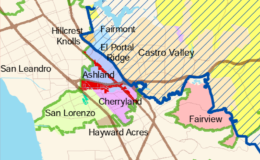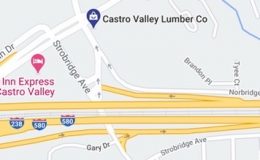I agree we should elect our MAC board.
An Elected Castro Valley MAC: The Affordable Truth
- By : Michael Baldwin
- Category : Featured Story, Governance, Local Control
Castro Valley could elect its Municipal Advisory Council (MAC) at a fraction of the cost asserted by Alameda County officials at recent Eden Area Livability Initiative (EALI) Governance Working Group meetings. Based on research of elections within Alameda County and throughout the State of California coupled with publicly available information, something is not adding up in how Alameda County has been estimating the cost of an elected Castro Valley MAC, by a lot.
EALI participants have been grappling with how to “enhance local self governance,” the top priority for the unincorporated Alameda County communities for local governance as determined by the nearly 200 participants at last November’s community charrette.
A recent straw poll at the Governance Working Group resulted in two concepts leading as ways to implement this goal: 1) An Eden Area MAC for Castro Valley, San Lorenzo, Cherryland, Ashland and Fairview, and 2) an elected Castro Valley MAC.
Alameda County Supervisor Nate Miley, whose district includes Castro Valley, currently recommends candidates for the Castro Valley MAC to the Alameda County Board of Supervisors, which in turn votes on whether to appoint the Supervisor’s nominees, as in the case of the the recent reappointment of MAC Chair Marc Crawford. The law that created MACs allows for them to be either elected or appointed – Alameda County’s Board of Supervisor’s opted for an appointed Castro Valley MAC when it was established.
At previous EALI Governance Working Group meetings, the County deemed that an elected Castro Valley MAC would be “economically in-feasible” because of the costs of an election, based on an Alameda County Registrar of Voters estimate that a MAC election cost per voter of $4 (at the low end). According to the County estimates provided at the EALI Governance Working Group meetings, a MAC election for all of Castro Valley’s 34,904 registered voters would cost $139,616. (see provided handout below)

This assertion contradicts to the Registrar of Voters own website (see image below) that states that an ENTIRE Countywide Consolidated Election would cost $4 to $6 per registered voter.
Adding elections for a seven-member elected MAC in Castro Valley to an existing ballot would clearly not add an additional $4 per voter to the costs covered by the county.

This begs the question, what would the actual cost for an elected Castro Valley MAC be?
In Alameda County, all election costs for non-county elected positions are billed back to the entity for which the election is being held. The Castro Valley Unified School District (CVUSD), Castro Valley Sanitary District (CVSan), and the Eden Township Healthcare District (ETHD) are three such independent governmental districts in Castro Valley that are sent a bill to cover the costs of their elections.
If the Castro Valley MAC were elected, the election would be held in the county polling precincts covering the Castro Valley General Plan area, which includes 61,388 people and 34,904 registered voters.

The existing local district with boundaries closest to this is the Castro Valley Sanitary District. The District serves a population of approximately 55,000, with more than 22,000 single and multi-family residences and businesses. Let’s explore how much CVSan pays for the elections of their Board, as their costs would naturally be similar.

CVSan has a five-member Board, elected to staggered, four-year terms. Two of the Board positions are up for election this November 4, while the remaining three seats will be contested in November 2016.
If the Castro Valley MAC were elected, they would likely have four of the seven members up for election during one General Election and then vote on the remaining three seats after two years.
In 2012, all three CVSan seats ran uncontested, so there were no election costs billed to the district. In 2010, the Alameda County billed CVSan $29,829.20 for its share of election costs for four candidates vying for three open seats.
In 2008, CVSan received a bill for $21,252.00 for an election with four candidates vying for two open seats. Based on CVSan’s 2010 and 2008 elections costs, it cost an average of $1.15 per household to elect the CVSan Board.
The actual costs of CVSan elections are well below the County’s estimates for an elected Castro Valley MAC. The actual costs of $29,829.20 for the 2010 CVSan election is well below the low-end $135,000 estimate for an elected MAC during a November general election. That is, the actual cost of the most recent election of CVSan was 22% of the estimated cost for a Castro Valley MAC election.
Another source to consider when estimating the cost of a Castro Valley MAC election is the paid for viability report for an incorporated “City of Castro Valley”, commissioned by the Alameda County Local Agency Formation Commission (LAFCO), for the failed incorporation attempt in 2002. As a part of this report, the County created a projected budget, including projected election costs for the incorporated Castro Valley through the 2012-1013 fiscal year.
LAFCO projected election costs for a five person City Council at $29,819 for the 2012 election cycle.
This report, approved and sponsored by the County, projects an $1 cost per registered voter. There is no reason to believe that this estimate would no longer be a valid estimate, and, as such, it is a reasonable assumption to base the costs of an elected MAC on the LAFCO report estimates.

Another local agency with a similarly elected five-member Board is the Eden Township Healthcare District (ETHD). ETHD is a community healthcare district that covers Castro Valley, as well as Hayward, San Leandro, San Lorenzo, and the unincorporated areas of Ashland, Cherryland and Fairview. In total, the district covers 368,620 residents with 206,427 registered voters.
In 2012, the District had three candidates running for two positions and was billed $180,223.05 by the County for their election costs. In 2010, the District had four candidates running for three positions and was billed $162,145.42 by the County. This averages out to a cost of $.82 per registered voter.
These three realistic cost scenarios can also be confirmed by other Counties in California. San Diego County (a County with twice the population of Alameda County,) has 18 Community Planning Groups (CPG) that essentially function like a MAC. They vary in size from nine to 15 members, and all of them all elected.
Here is what Jennifer Uebbing from the San Diego County Registrar of Voters office had to say:
The cost ranges from $0.19 to $0.35 per voter.
For San Diego County, we assign election costs in a consolidated election through the use of a weighted average method. This attributes costs to each jurisdiction based on the number of contests; the number of registered voters; and the number of sample ballot pages. The number of participating jurisdictions and the number of contests changes with each election.
We have 18 community planning groups (CPG) within the county. However, the number of CPGs on the ballot depends on the number of people who sign up as candidates. For example, Alpine CPG has seven openings, and during candidate filing only seven people file for candidacy, that CPG will not go on the ballot. The Board of Supervisors will appoint the seven people to the CPG.
San Diego County has 1,530,462 registered voters as of September 6, 2014. We translate election material into four languages, Spanish, Filipino, Vietnamese and Chinese. Some of the differences between the counties are the number of registered voters, number of languages that they support (translation), the number of poll workers recruited and trained, the number of poll sites, the printing of the sample ballot pamphlet and ballots, postage for mailing the sample ballot pamphlet and vote-by-mail material and labor costs.”
San Diego County’s method for estimating election costs is essentially the same as Alameda County, which Alameda County Registrar of Voters Tim Dupuis explained to me in an email:
We are required to translate all our material into the 5 primary languages in Alameda County – English, Spanish, Vietnamese, Chinese and Tagalog. We are allowed to target language translation for the additional four languages that we picked up in the last census – Hindi, Khmer, Korean and Japanese.
Every cost incurred to run an election is captured – staffing, printing, training, distribution, postage, outreach, warehouse materials, vehicle rentals, communication, office supplies, software licensing, equipment maintenance, etc. At the end of the election, these costs are spread to each jurisdiction based on total number of voters within each jurisdiction. The more jurisdictions can consolidate on to one election, the lower the cost to the jurisdiction. This is why almost all cities in Alameda County have consolidated their elections to the November General Election.
An elected Castro Valley MAC is an affordable and “economically feasible” option, as demonstrated throughout the State, and even in our own county when you look at election costs for comparable districts like CVUSD, CVSan, and the ETHD.
If the EALI Governance Working Group is tasked with estimating the economical feasibility of electing the Castro Valley MAC, it deserves the luxury of working with the correct cost assumptions. Adding MAC positions to the November ballots would likely only cost about $30,000 per election cycle, which makes the option far more feasible, and worthy of consideration. In fact, eliminating the $50 per meeting stipend to MAC members alone would free up $25,200 in County funds every two years -just about enough to pay for the election.


